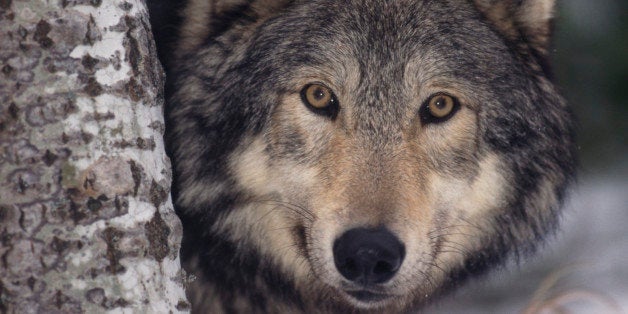
For the first time since the 1940s, there's a wolf roaming the Grand Canyon.
The wolf has been repeatedly photographed at the North Rim of Grand Canyon National Park and the nearby Kaibab Plateau since early October. DNA tests on feces on Friday confirmed it's a female wolf who wandered some 450 miles south from the northern Rocky Mountains, the same area where wolves were reintroduced to Yellowstone nearly 20 years ago.
The Grand Canyon wolf sent a shiver of excitement through wildlife advocates, especially those of us fighting to bring wolves back to the American landscape. We know that with protection and a little bit of tolerance, wolves can regain their footing in many of the places they were driven out of a century ago.
This wolf is a perfect example of how it works: As wolves establish packs in places like Yellowstone and the surrounding areas, lone wolves set off in search of new territories in the hopes that mates will follow and new packs will be born.
But this female in Grand Canyon is also a prime example of America's wolf restoration program at a crucial crossroads.
This wolf is protected now under the Endangered Species Act so, today, if she wanders out of Grand Canyon National Park, she can't be legally killed.
But the Obama administration is poised to change all that. In the coming weeks or months, the U.S. Fish and Wildlife Service is expected to finalize a plan to strip Endangered Species Act protection from nearly all wolves in the lower 48. That means wandering wolves like this one could be shot on sight or subjected to some kind of hunting or trapping season -- the same sort of persecution that pushed them to brink of extinction.
The decision will abandon 40 years of wolf recovery and declare the job finished, even though wolves occupy less than 10 percent of their historic habitat in the lower 48. It will also foreclose any real possibility that wandering wolves -- like the one that showed up this fall in the Grand Canyon -- will be able to establish a home in places where their ancestors lived for thousands of years.
Earlier this month, the Center for Biological Diversity released a first-of-its-kind analysis identifying more than 359,000 square miles of additional (but unoccupied) wolf habitat in the lower 48 states, including in the Northeast, West Coast, southern Rocky Mountains and even the Grand Canyon.
Over the past 30 years, there've been more than 50 instances where wolves have trekked out of their core recovery areas and into places like Colorado, Utah, New York and Maine. Too often they're quickly killed -- but not all. Perhaps the most famous is OR-7, the Oregon wolf who, in 2011, became the first documented wild wolf in California since the 1920s. He has since found a mate and started a family.
Each of these wandering wolves carries the potential for the restoration of wolves. It's easy to imagine the sound of wolf howls echoing off the walls of the Grand Canyon and through valleys and riverways across the West, a primal call that lived in these places for generations and belongs there still.
The Grand Canyon wolf, in her own small way, offers the promise of return. The question now is whether we'll let her stay.
